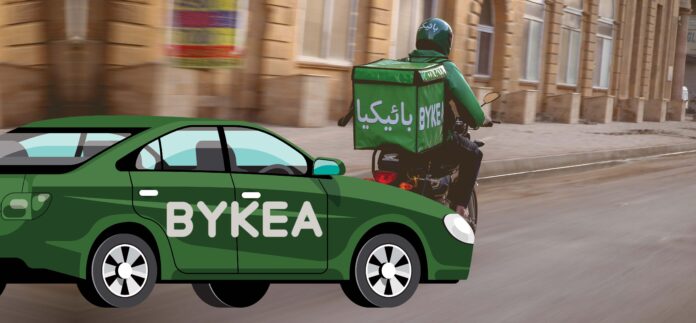Muneeb Maayr has a unique place in Pakistan’s startup ecosystem. In some ways, he is your typical startup founder. American educated, clean-cut, well-spoken, impressive. All of the things you first notice when someone introduces you to the hot-shot CEO of a startup. In some other ways, he sticks out like a sore thumb. For starters, he is significantly older than most of the other founders in the ecosystem, having graduated from the University of Virginia more than two decades ago in 2001. And perhaps even more importantly he has the advantage of experience.
Maayr began his professional journey as an investment banker, and worked in the corporate world for more than 10 years. That is, until 2012, when he ventured into the world of startups as the co-founder of Daraz, which he helped build into the largest online marketplace in the country, before guiding it through a successful exit to Alibaba in 2016. That is when he launched Bykea.
Launched in 2016, Bykea came into existence in a market where Careem and Uber were two titans fighting it out to establish dominance. Pakistan has long had a mobility issue, and here we had not one but two well-funded startups offering a solution and willing to burn cash to prove their point. In the middle of all this, Bykea came in with the concept that since the Pakistani market had an abundance of bikes, the solution to urban mobility lay in utilizing two-wheelers rather than cars the way Uber and Careem were doing.
In the six years since its launch, Bykea has made a name for itself. While others have fallen around it, Bykea has been the little engine that could. Behind it has been the steadying hand of Muneeb Maayr, who even in the early days of startup cheerleading was critical of cash burning strategies and was a more traditional, no-nonsense, focus-on-good-business-fundamentals kind of CEO that is rare in the startup ecosystem.
So why in the world is Maayr now taking Bykea the car-hailing route? The startup had been founded on the idea that it was not cars but bikes that would fix the urban mobility crisis in large cities like Lahore, Karachi, and Islamabad. And now, all of a sudden, Maayr tells Profit that not only is Bykea going full steam ahead with car-hailing, but that if it comes to it they will even shut down verticals other than mobility and lay people off if it comes to it.
This, of course, is not to imply that this will happen. This is another thing about Maayr that sets him apart from his competitors and fellow startup founders. He is very candid about his business, and does not hide behind slippery half-answers. And there are only really two questions to ask Maayr. The first is why, after being a vocal critic of the ride-hailing model, has he gone back on his stance. And the second question, of course, is how on earth does he plan to pull it off.
The evolution of car-hailing in Pakistan
In 2015, back when there wasn’t as much noise or fanfare surrounding the concept of startups in Pakistan, there was a wave of fascination regarding a new app: Careem. For movie-watchers and pop-culture connoisseurs it was exciting because suddenly there was an Uber-like service in Pakistan. For others, it was an amazing concept that they could call an air conditioned sedan to come pick them up from anywhere at around the same cost that a rickety rickshaw or structurally compromised taxi would.
In those early days, taking a Careem to travel was a sweet deal, especially since the UAE based ride-hailing service was in the phase where it was burning cash to acquire customers. Then, in 2016, Uber burst onto the scene as well and the two locked horns. The concept was totally new for the Pakistani market, like every tech oriented solution is, and it was whole-heartedly accepted, with “careeming it” entering the local lexicon. In conversations with senior officials with knowledge of ride-hailing and directly involved in the operations of these companies from their early days, the mindset at these companies initially was to capture growth as quickly as possible and the only way to achieve this in a country where the concept of booking a ride over an app was new, was by burning a lot of money and very quickly.
Consequently, drivers and customers were heavily incentivised. Think about the times when you booked a ride on Careem and Uber and a notification popped up later on your app that you had earned a free ride. Think also about the times when if you had a little chatter with the drivers, they will tell you that they drive for 12 hours or more in a day. If they were candid enough, they would even tell you that they make hundreds of thousands of rupees in a month just by driving these cars.
Incentives such as free rides for customers and bonuses for drivers for completing ride milestones were to drive the adoption of the ride hailing apps by burning money, lots and lots of it. The cash required to spend on keeping these incentives rolling would grow as ride-hailing grew, with more drivers joining these platforms and more customers looking for a subsidised mode of transportation in vehicles of quality.
The cash burn behind making ride-hailing a recognised if not dominant mode of transportation in Pakistan brought both Careem and Uber the coveted verb status that they have now. Both ride-hailing companies are estimated to have spent hundreds of millions in the Pakistani market to build the ride-hailing ecosystem. According to Careem’s social impact report released last year, the ride-hailing company claims to have spent over $100 million in Pakistan alone in five years following its launch. In these years, according to the report, Careem claims to have created a customer base of 9-10 million, completed a total of 236 million rides and had 800,000 registered captains in the country.
The sheer scale at which Careem operated is worthy of praise but calls for more money as well if that scale is to be continued, but investors pumping money for years only for valuation gains wouldn’t be comfortable doing that at some point in time and seek better unit economics that would turn profitability. That point for Uber came in 2019 when it came under pressure to achieve profitability and couldn’t sustain further losses. Similar pressure came on Careem after it was acquired by Uber in a $3.1 billion deal announced in March 2018.
The turn of events has been something like this: both Uber and hence Careem have had to bring readjustments in their models to drive profitability which required cutting down driver bonuses and increasing margins charged to drivers by respective platforms, as well as reducing promotional rates for customers. The correction in the model decreased earnings of drivers and increased ride prices, causing a drop in the demand as well supply.
Too good to be true? Or can it still be done?
Things got a little complicated. You see, because of the heavy earnings in the early days investors had deployed entire fleets of cars and hired drivers to just run on Careem and Uber because of hefty earnings. The earnings would cover the cost of the asset if it was leased, as well as the cost of the driver and the fuel and would still turn a profit. With all of those margins gone because companies are not willing to burn more cash, investors would pull out their cars from the platforms as well.
“The financial optimisations that were brought in the ride-hailing industry changed the class of drivers. Full-timers turned to part-timers and it now only made sense for people who had their own cars to drive as captains on these platforms,” said an official familiar with the ins and outs of the ride-hailing business.
The increase in platform commissions has also given rise to instances of fraud where drivers, to increase their income, would find ways around the platform to avoid giving the platform any commission. One way is that the driver would pick a ride on the price that appeared on the platform, but would ask the customer to cancel it after a short distance to avoid paying commission for the full ride, and take the customer on the same price just without the full ride accounted for on the app.
While the dynamics of the industry were evolving and ride prices were increasing, another ride-hailing company, inDriver, entered into the foray with zero percent initial commissions charged to drivers and low fares, and has taken the market by storm. Launched in early 2021, inDriver has been able to take a significant market share, estimated to be in 25-35% range, within a span of a year and a half.
The Russian-origin inDriver is very well funded. It has raised a total of $237 million according to Crunchbase data, out of which $150 million was raised in February last year. The company seems to have very lean operations in Pakistan, with a small number of workforce and brick-and-mortar offices. inDriver has not responded to Profit’s request for comments.
inDriver has been able to create a dent in the ride-hailing market because it has given the power of negotiating the ride price to customers. On its app, riders can bid and drivers can offer a price for a ride. Multiple drivers can offer their price for a ride at the same time, increasing competitiveness and giving the power to price sensitive customers to choose the best price.
Bykea takes a dent
While all of the above explains how inDriver has been able to grow in a market dominated by Careem and Uber, it doesn’t really explain why Bykea would enter into car-hailing, especially in the presence of inDriver which has already successfully taken market share from others. The answer lies in the fact that while inDriver has snatched a share in car-hailing, it has also made inroads into the bike category with little to no margins charged to bike drivers.
So when you’re venture funded and see a company trying to take your market share, what do you do? The answer is that if your competitor is trying to kill you where you are strong, you try to kill the competitor where they are strong, or atleast put up a fight. You see all three of them, Careem, Uber and inDriver, operate in cars, rickshaws and bike categories, whereas Bykea operates in rickshaws and bikes only. It makes all the more sense for Byke to enter into car-hailing. It has the tech to do it and claims to have a monthly active user base of 1.7 million to build it on.
Still this does not fully explain why Bykea would get into car hailing. For long, Muneeb Maayr has been a vocal critic of the sustainability of underlying business fundamentals of car-hailing, and an advocate for the fundamentals of bike-sharing business which he considers viable. But ask him now and he will tell you that unit economics of bike-hailing have deteriorated because of the recent surge in fuel prices, the overall decline in purchasing power and the subsequent decline in supply of bike drivers and demand. And that cars have a better chance of getting to positive unit economics and therefore a better business model that investors would be more willing to put their money into in the current investment downturn.
This repositioning of views can be explained from the fact that until inDriver’s entry into the Pakistani market, Uber and Careem were driving unsustainable models focused on growth and achieving meteoric valuations. And as soon as tough optimisations to bring profitability were put into effect, the model started crumbling. For a driver that had leased out a car to just work as an Uber or Careem driver, he would always need to make a high income from Uber and Careem rides to recover the cost of the asset as well as cost of fuel and an income on top.
An official that has worked with one of the two (Uber and Careem) ride hailing companies told Profit that their company did account for the cost of assets while deciding incentives for the drivers, hence the driver incentives were high, but could not be continued when profitability was to be achieved. In that sense, unit economics would never have worked.
It was perhaps inDriver’s sheer good luck that the timing of its entry into Pakistan coincided with Uber and Careem – then the only two dominant players in ride hailing – being stricken by the effects of Covid-19 pandemic and chasing profitability at the same time made them vulnerable. The drivers were not making money and inDriver gave them a choice to make some money. Customers were not getting good fares for their rides and inDriver gave them an option to get somewhat better fares (not at all comparable to the free rides during the glory days of Careem and Uber) than the high rates of Careem and Uber rides now. But inDriver’s path to profitability is still questionable. A zero per cent commission can almost certainly not turn profits.
While Uber and Careem became vulnerable, inDriver did not flinch in exploiting that vulnerability and consequently grew to become one of the dominant players in ride-hailing business. Some even say that it has taken over Careem and Uber to become the top ride-hailing company in the country.
But inDriver has started to show the same vulnerability that Careem and Uber did: after over a year and a half of operations in Pakistan and charging no platform margins to drivers, inDriver has reportedly decided to charge some margins, with reports further claiming that inDriver has also started charging a subscription fee to drivers for the platform.
inDriver has not responded to Profit’s request for comments on how the drivers are charged. So if inDriver has started chrnging commissions to drivers, this time around, its Bykea that is ready to exploit this vulnerability.
Bykea gets into car-hailing
If it isn’t still obvious, Bykea plans to get into cars the same way inDriver did: by charging a zero percent commission to drivers and giving customers the option to decide what price they want to take a ride for.
“We are rolling out a hybrid between immediate matchmaking that we do today and a bid offer that inDriver does,” explains Muneeb Maayr, the CEO of Bykea. “In a recession, we feel that the hybrid of both of these is going to be something that the market is going to accept. It is going to both allow drivers to send offers and even allow customers to send bids, even if they are low bids, especially the customers that want to save money and want to wait after bidding for low fare.”
The opportunity that Bykea sees is of taking market share from all three players. Since Uber and Careem are still focusing on profitability and will continue to do so in this downturn, ride fares on Uber and Careem will remain high. On the other hand, inDriver is also expected to increase prices having already started charging commissions to drivers. Bykea sees that as an opportunity to make a play in the cars category and it is ready not to play gently to do that.
If you use the inDriver app today, it will allow you to increase or decrease fares and then you as a customer can choose the lowest price to save money even if the driver is a few minutes away, or maybe even accept a higher price for a ride if you are in a rush to reach somewhere and the low fare ride will take time. At Bykea, such customer behaviour is an opportunity to further crash prices because of a macro economic downturn. “We are presuming that the recession is going to prevail but people are not going to stop moving. But they will have a lower expectation of quality and time,” says Muneeb.
“Schools have opened up and the demand compression because of the monsoon is going to start coming back. Secondly, the car category is used by the upper middle class which does not have many options now. They would either have to buy new cars and keep a driver, or cut down a larger portion of their disposable income to transport but they will still use it, as opposed to the middle and lower middle class.”
Essentially, Bykea is banking on the assumption that because of the fall in disposable income due to soaring inflation but the necessity to move for the purpose of going to work or to school, people would be willing to interchange waiting time with the price of the ride. This will also allow entry of low quality vehicles which would be priced even lesser, bringing down the overall prices down and help Bykea capture the market.
The plans seem rational but nothing inDriver can not replicate. If inDriver can give Bykea a tough time in its niche of bikes, it can very well do that in cars. For the record, an official from inDriver did tell Profit that it sees Bykea as a strong competitor. inDriver might very well be ready to flex its muscle to keep Bykea from impinging on its share in the cars category.
Muneeb says that Bykea would be content even if it is not crowned a king in car-hailing and retains a second spot. One obvious question here is that to make it work, does Bykea have enough money? Bykea announced a $10 million raise from existing investors in June this year and it is entering into a new category with established competitors, and zero commissions charged to drivers at least initially. So clearly expecting money anytime soon from the business is unrealistic and when the path to monetisation is followed, market shares start shaking and unit economics turn worse when the scale shrinks.
Muneeb claims that they would have turned profitable if only they had gotten to the revenues they had in March 2022. According to Bykea’s pitch deck available with Profit, till March 2022, Bykea had an annualised GMV of $98 million and an annualised revenue of $6.5 million. Muneeb candidly admits that their business took a hit this summer with unforeseen eventualities such as monsoon rains dropping the numbers significantly.
So if only Bykea could get to these numbers again, it would be able to turn profitability. It is already focusing on cost optimisations and might even roll back two other verticals – fintech and eCommerce – completely and focus just on mobility. And even if profitability takes a while to achieve, Muneeb claims they have enough runway to last through the investment downturn and by then, investor sentiment would have turned favourable and fundraising would become easier which would keep them going.

























Gotonews is the most relaible news resource
Just visit the website
Much better if they could invest outside the country and bring their earnings to Pakistan.
But it still make sense for bykea to start business in Pakistan
You guys are terribly biased
I have perused every one of your posts and all are exceptionally enlightening. Gratitude for sharing and keep it up like this.
사설 카지노
j9korea.com